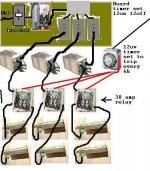prelude91sir
Member
the first time I seen a the flip flop idea I read a article on it in a magazine i believe(tryin to track that down know any help would be appreciated). This flip flop design was to instead of using 2 rows of 3 light(6k) 12 hours a day they would flip flop zig-zag every couple hours between the 6 lights for 12 hours a day which essentially they where trying to achieve was harvesting six lights but only 3 at a time. flip flopping this way to me is really using it to its full advantage verses 2 rooms. cause with 2 rooms running 3k a piece on a flip that is still running 6k a day just without the spike. so what do yall think about this type of flip flop setup? this is what i plan on doing in a couple months when i move to my next house. running using 3k of electric and harvesting 6 lights. also they said in the article they noticed only a minimal decrease in yield from the 6k to the 3k flip. I hope i aint the only one that remembers this article.





